Mad Scientist Day 2012: Ten “Sweet” Experiments

August 9, 2012
If Bea had Soap Making on the top of her Summer of Funner 2012 wish-list, the one thing that Tobes wanted to do was to “smash Skittles” [the kids absolutely love Skittles] and “make them into potions.” The kids’ idea of backyard “potion making,” however, isn’t very productive. They tend to take food or flowers or whatever they can find, grind it up, mix it with water, and pour it on the sidewalk chanting “Ex-pelly-ahh-moose!” et cetera.
Looking back upon last summer’s Eggsperiment Day as a highly successful foray into scientific discovery, I decided to look into various ways that we could use Skittles and other candies in a likewise “Scientific Manner.” Drawing heavily from the phenomenal Steve Spangler Science website (I wish I’d seen this last year when I was designing the Eggsperiments!), I transformed a few basic experiment ideas into “magic tricks” that I could perform in order to lure the kids into a series of further sweet spells and queries. The kids are already used to “candy math” (my fool-proof way of getting them to learn to Skip-Count, multiply and divide), so I was sure the day would be a success, no matter if the experiments were failures or successes! And of course it was! You can’t go wrong with candy! We may just have to turn this into a Kids Birthday Party Plan for one of ours next year!!!!
Below, you’ll find a recap of our 10 Sweet Science Experiments with a photo gallery to follow each.
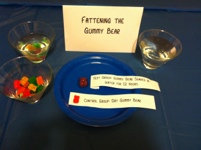 1) Mama’s Magic Trick: Fattening a Gummy Bear Overnight
1) Mama’s Magic Trick: Fattening a Gummy Bear Overnight
Materials: Gummy Bears, Glasses of Water
I didn’t want to tell the kids we were doing “Candy Experiments” until the morning of our experiment day, so I gave the kids a few gummy bears after supper as well as a cup of water. This way, they wouldn’t think anything was funny when they saw them around the house. After they went up to bed, I dropped a gummy bear in a fancier glass and set it on the counter. In the morning, the kids came down to find fat bears in water! We took them out and compared them to dry original bears in terms of size and feel. I asked the kids how they thought this would happen, handing them their Yesterday Books in order to record their hypotheses. Then, I told them how it worked: The gummy bear is made of glucose starch and gelatin. All of these substances absorb water when placed in it. But the starch and gelatin in the bear prevent it from dissolving the way that sugar normally does in water. So it swells up. Then, the kids floated a few more bears of their own to see how fast it worked! It only took an hour or so for some “substantial” results! The kids went on to hypothesize that you could do the same with Gummy Worms etcetera. Perhaps for a kids’ birthday party, we could make “Fat Worms” – put that on the list of “Things to Do!”
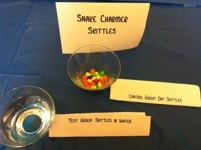 2) Magic Trick: “Snake Charmer” Skittles
2) Magic Trick: “Snake Charmer” Skittles
Materials: Skittles (or M&Ms), Water, Cups or Bowls
If you drop a skittle face up in water, the colour slowly bleeds out and the sheet of thicker, edible sugar on which the “S” is printed slowly pulls away from the top and floats to the surface. Again, I didn’t tell the kids what would happen for this one. Instead, I told them to drop their skittles in the water, point to the ramekin and ask the bowl “What sound does a snake make? Tell me magic water, What sound does a snake make?” It was pretty hysterical! The kids then practiced this “trick” on each other. Then, we discussed the rationale of why this happens, namely, that while the colourful sugar coating of the candy dissolves almost immediately in water, the “S” is printed in edible ink on an edible papery substance (like the edible rice paper wrappings on some Japanese candies we’ve tried.) which, while it may have some sugar in it, is lighter and buoyant, rising to the top before it, too, dissolves, especially if you touch it!
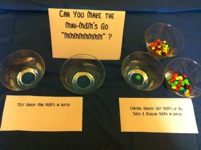 3) Experiment: Can You Make the Mini-M&Ms Say “Mmmmm”?
3) Experiment: Can You Make the Mini-M&Ms Say “Mmmmm”?
Materials: Mini M&M’s, Water, Cups or Bowls
I had read that you could do the same as above with M&Ms, and such is the case. However, we remembered that sometimes experiments with larger or smaller versions of an original object will not produce the same results. So, the kids tried to see if they could make teeny tiny ms rise from the water. Hypothesis? The tiny “M”‘s will rise. Result: The tiny “M”‘s did rise! 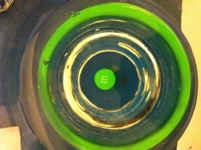
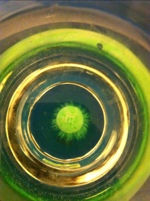
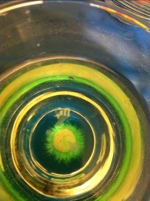
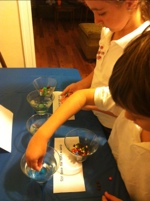
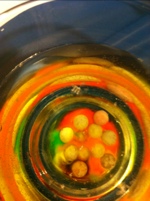
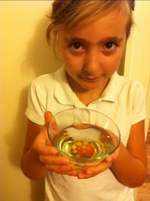
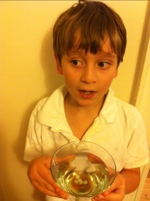
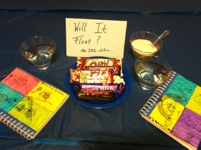 4) Favourite Experiment: “Will it Float? The Candy Edition”
4) Favourite Experiment: “Will it Float? The Candy Edition”
Materials: Various Candy Bars, Water, Sugar, A Large Clear Vessel, Spoon/Stirrer Stick, Paper & Pencil to Record Results
For one of last year’s Eggsperiments, we tried floating fresh and hard boiled eggs in water and then in salt-water solution, discussing the notion of a denser or “heavier” solution would make an object that sank in water float. This year, we tried to float various candies and chocolate bars in a vessel of water. (I cut slices of some of the larger bars and broke of squares of those that I could and put the rest of the sugar-stuff away – out of sight, out of mind!). Then, we tried to float the same treats in a sugar-water solutions (added gradually in x3 teaspoon increments) and tabulated our results in our Yesterday Books. The candies that floated in water were: Marshmallows, Kit Kats, and Aeros. The candies that were no-floats were: Dairy Milk (chocolate bar), Snickers, Twix, and Mars. Our Hypothesis: The candies with air trapped inside of them miraculously floated in water. The candies without air trapped inside sank in water!
Then on to buoyancy in a sugar solution… Of the candies on the no-float list, none floated in a martini glass of water mixed with 3 teaspoons of sugar. Of the no-float list, Twix and Mars slices floated in a martini glass mixes with 9 teaspoons total sugar while Snickers and Dairy Milk did not float. In 18 teaspoons of sugar plus the water in the martini glass, neither the Snickers nor the Dairy Milk floated. In 24 teaspoons of sugar plus the water in the glass, the Snickers floated. The solid Dairy Milk bar still did not float! The kids hypothesized, however, that the bar would float if we made a thick enough mixture, but they did not want to use any more of our “baking sugar,” as they called it, to test it out!
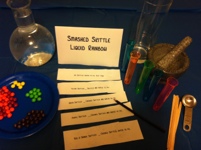 5) Experiment: Smashed Skittle Liquid Rainbow – Failed this Time but Fun – Requires Further Testing!
5) Experiment: Smashed Skittle Liquid Rainbow – Failed this Time but Fun – Requires Further Testing!
Materials: Several Skittles, Water, Cups or Dollar Store “Test Tube” shot glasses, Mortar and Pestle, Funnel, One Tall Narrow Empty Vessel, Spoons or Droppers
Here, Tobes FINALLY got to smash his Skittles! Pure heaven! First, we separated the skittles out into groups by colour. Then, we took a different amount of skittles per four colours: 5 Yellow, 10 Green, 20 Purple and 40 Orange & Red. We smashed them in a mortar and pestle with 2 tbs water, so that the sugar coating dissolved into our water and the gooey bodies were separated. Then, we poured the coloured sugar water part through a funnel into our “test tubes,” and topped the tubes up with water, stirring until combined. We made sure that there was an equal amount of substance in each cup, knowing that each cup had a different amount of sugar or a different density. This took a while, and it was totally fun. Then, we poured the most sugary substance into the bottom of our clear vessel, following from greatest to least amount of sugar, attempting create a density rainbow of skittles. Unfortunately, we did not have a different enough density between the test tubes for this experiment to work! We ended up with a glass full of purply orange goo. Still, it was fun! The kids hypothesized that if we used a special eyedropper to disseminate our liquids, and if we had a greater range in amount of skittles per colour/equal-sized container, the experiment would probably have worked! The most important part of this experiment was the SMASHING!
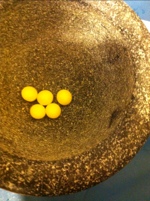
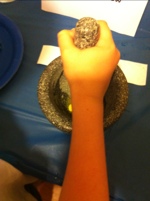
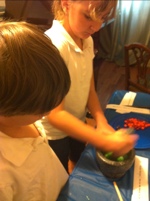
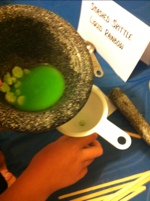
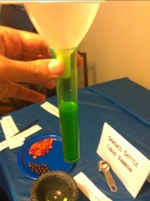
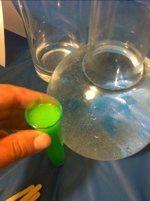
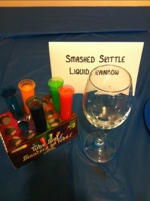
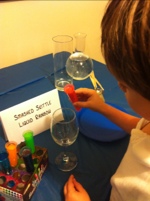
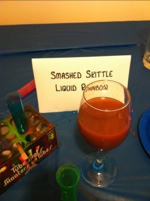
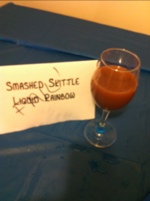
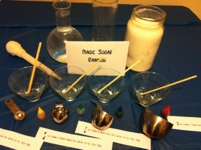 6) Centerpiece Experiment: Magic Sugar Rainbow
6) Centerpiece Experiment: Magic Sugar Rainbow
Water, Sugar, 4 cups, Food Colouring, One Clear, Tall, Narrow Empty Vessel, Stir sticks or Spoons, Turkey Baster
The basis for this experiment is the same as the previous one – by dissolving different amounts of sugar in water and colouring them, you can build a “rainbow” in a glass by layering the liquids from the most to the least dense. This time, I let the kids figure out how to do it all on their own, leaving them with measuring cups, droppers of food colouring, sugar, water,and stirrer sticks. We had four equal sized martini glasses. The kids put 1 tsp sugar into a glass and filled it with 6 drops yellow food colour and water to just below the brim. In the next, 1/4 cup sugar, 6 drops green and water to the brim. In the next, 1/2 cup sugar, 6 drops blue, and water to the brim. In the last, 1 cup sugar, 6 drops red and just a bit of water to the brim. Then, we stirred and stirred until each solution was dissolved. Finally, we used a turkey baster to add the liquids, from thickest to lightest, to a tall narrow glass vase. This time, we had success! The red stayed firmly at the bottom. While the blues and greens muddled a bit, there was definitely gradation of colour as it rose to the top of the vase. The yellow, of course, became green, but there was still a gradation of colour from top to bottom! Fun, fun, fun!!!!
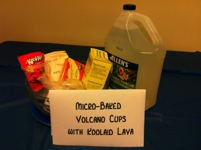 7) Festive Magic: Micro-Baked Volcano Cups with Koolaid Lava
7) Festive Magic: Micro-Baked Volcano Cups with Koolaid Lava
Volcano: Salt-Dough (a 2:1:1 solution of flour:salt:water + Food Colour), micro-safe cups, plate or tray
Lava: Vinegar, Red Koolaid, Baking Soda, cup and spoon
Two summers ago, before I stared keeping track of our fun online, the kids and I made volcanoes out of clay and then tried the two basic tricks of exploding vinegar and baking soda, and diet coke and mentos inside of them. This year, we revisited ye old Volcano experiment by baking Salt Dough volcanoes in the oven and by “Sweetening” our pot. This year we made salt dough with a little colour, mixing 2 cups flour, 1 cup sugar, and 1 cup water with some food colouring. Then, I had the kids mold free-form volcanoes around two somewhat-microwaveable plastic cups and we micro baked them on plates, first for a minute, then for 30 second bursts until mostly dry. (See our Salt-Dough Ornaments post for oven-baking info, or just use a cup or tin can as your volcano!). I had the kids place their volcanos on trays and fill their centers with baking soda. Then, I had them mix their vinegar and koolaid in a separate cup. We poured these into our volcanos and stood back to watch them erupt!
Finally, we refreshed our memories about how and why this works: When Baking soda and vinegar are combined, the Acetic Acid in the vinegar reacts with Sodium Bicarbonate in something called a “Double Replacement Reaction .” The reaction between the acid and the bicarb almost immediately form something called carbonic acid. However, the carbonic acid is so unstable that it just as quickly breaks apart into carbon dioxide and water. The bubbles in the “lava” are actually the carbon dioxide esscaping. In the end, what “escapes” the volcano are Water, Sodium Acetate, and Carbon Dioxide.
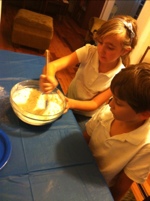
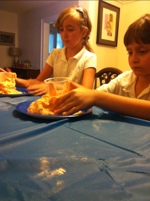
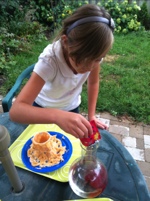
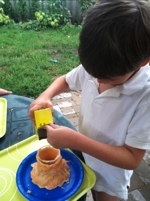
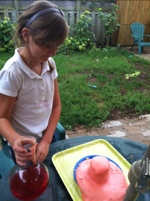
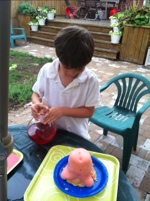
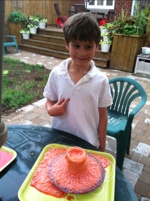
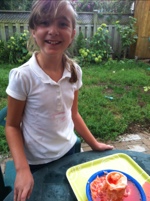
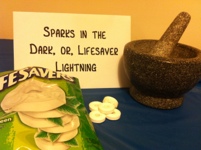 8) Unphotographable Experiment: Sparks in the Dark, or, Lifesaver Lightning
8) Unphotographable Experiment: Sparks in the Dark, or, Lifesaver Lightning
Wintergreen Lifesavers, A Dark Room, A Good Strong Mouthful of Teeth or a Mortar and Pestle
The kids went into a dark closet and bit into their lifesavers -and they saw sparks!!! Then, they took the mortar and pestle to the lifesavers and found more of the same. Apparently, all hard candies emit some light when you bite them. This effect is called triboluminscence. But Wintergreen lifesavers are flavoured with methyl salicylate, or oil of wintergreen, which is flourescent, absorbing light that is of a shorter wavelength and emitting light of a longer wavelength than just plain old candy. Who knew? Of course the kids tried to “bite” down on other candies in order to prove the lightning power of the wintergreen over all others….Who wouldn’t test a bunch?
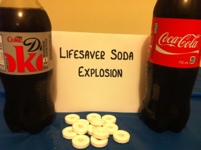 9) More Festive Magic: Lifesaver Soda Explosion
9) More Festive Magic: Lifesaver Soda Explosion
Wintergreen Lifesavers, possibly a Mortar and Pestle, Meat Cleaver or Hammer & Board, Bottles of Soda, Paper Funnel
This time, we attempted to re-do ye olde Mentos in the Diet Coke Explosion experiment by swapping Mentos for our Wintergreen lifesavers and diet coke. Our lifesavers came in a bulk pack and so were larger than the ordinary kind, so the kids used smashed bits from the previous experiment. They made a paper funnel and quickly dropped several wintergreen lifesavers into a just opened bottles soda. Then, they stood back and watched the magic happen. The lifesavers geysere were larger than the ones we made with the mentos two years ago! Spectacular!
Why does this happen? Well, carbon dioxide is always escaping soda bottles once they are opened. However, because of their ingredients and rough surfaces, items like Mentos, and, to a slightly lesser degree, this year’s Wintergreen Lifesavers, cause that build up and escape of gas to occur much more quickly.
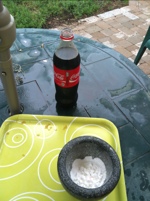
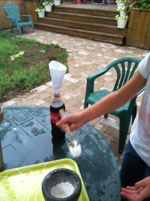
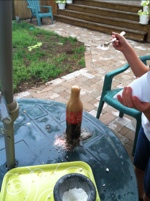
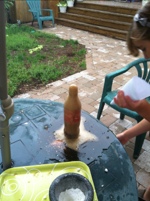
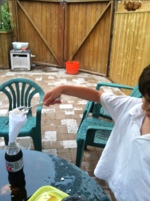
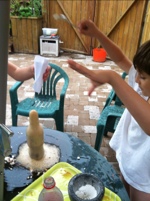
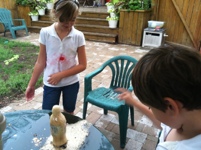
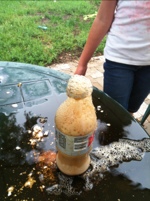
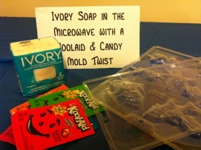 10) Ye Olde Exploding the Ivory Soap in the Microwave trick…with a Candy Mold Finish for the Soaps!
10) Ye Olde Exploding the Ivory Soap in the Microwave trick…with a Candy Mold Finish for the Soaps!
Materials: Ivory Soap, Microwave-safe Plate, Waxed or Parchment Paper or Paper Towel, Microwave, Koolaid or Food Colour, Candy Molds or Cookie Cutters
Place an unwrapped bar of ivory soap on a plate or piece of thick paper towel in the microwave. Microwave for 45 seconds – 2 minutes until the soap “foams” turning into a cloud! Watch it carefully! It gets quite large. You don’t want to overcook! Apparently, two scientific transformations occur here. First, you are heating and, hence, softening the soap. Second, you are heating the air and water trapped inside of the soap. Thus, the water vaporizes and the air to expands into a foam. But what to do with the foam? Make candy mold soaps again, or snow, or lather up and get rid of all the evidence of candy mess! Careful! After a while, if you haven’t already tested the soap out in the tub to see if it still lathers (and it does!), it will crash open and break into thousands of tiny shards.
Here are things we did with it (with many thanks to the best bites blog for the inspiration which led us to our “candy mold” tweak). Soap 1 (we had a three pack): Place soap foam into a big bowl, add warm water enough to make the soap back into a pliable clay type substance. Divide the mush and colour with koolaid or food colouring. Form into shapes or press into CANDY MOLDS or cookie cutters. Of course we used Candy Molds, because it was the perfect day for it! Our soaps didn’t turn out that great, to be quite honest, but the kids enjoyed looking at them through the molds. Soap 2: Bring it into the tub, smash it, or make it into lather. Soap 3: Let mama hold it over your head and crumble it into snow over top of you (also in the tub).
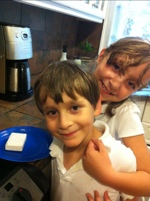
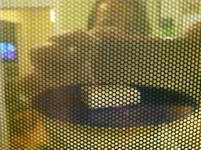
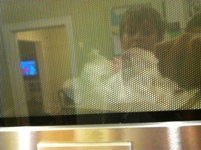
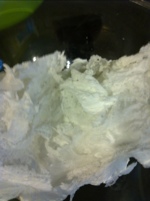
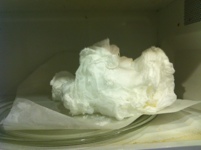
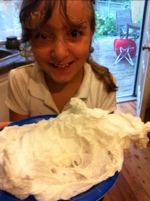
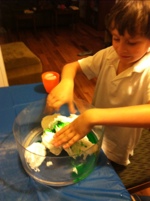
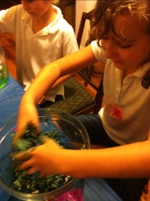
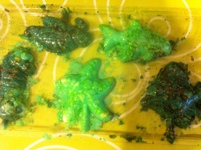
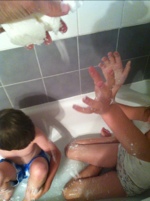
________________________
Quick Links for Mobile Users
Summer of Funner : The Lunchbox Season : In Defense of Burning

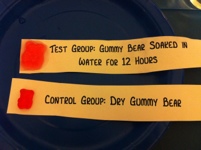
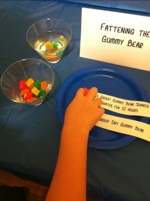
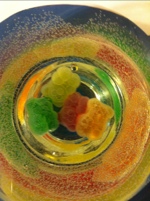
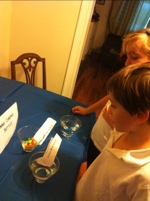
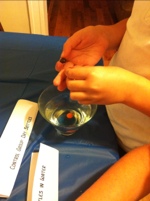
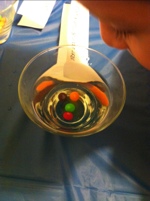
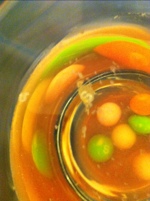
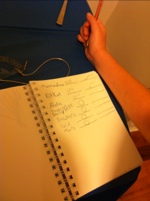
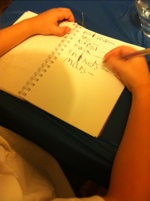
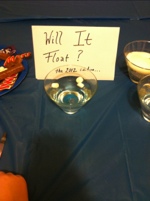
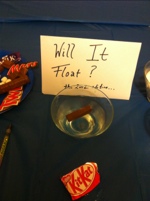
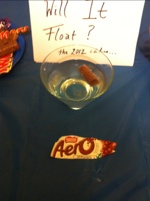
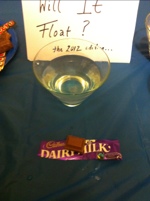
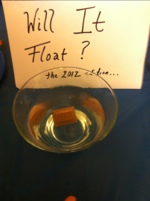
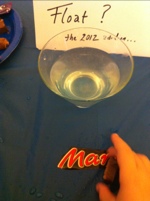
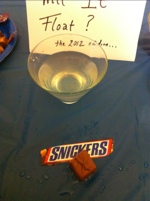
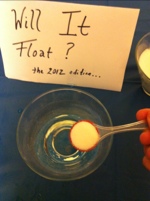
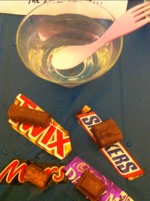
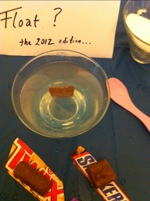
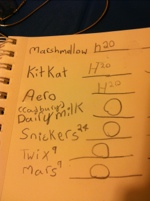
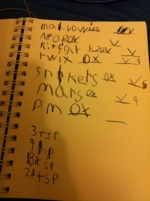
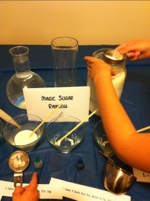
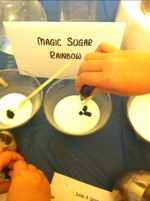
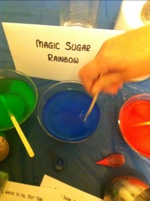
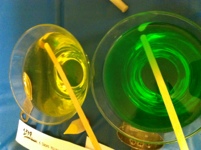
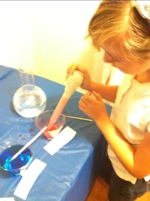
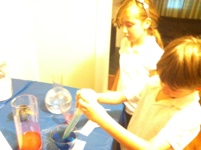
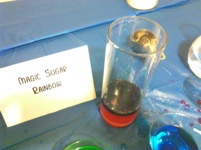
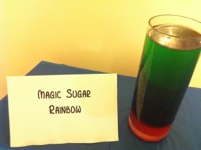











 We haven’t played many games on our food days this year…so it was about time we got down to some funny business. I told the kids that it was time to play, “Name That Crazy Fruit,” and I handed each of them a set of nine cards with the names of a Crazy Fruit printed on each one. I asked the kids to place one card beside the plate or bowl filled with the fruit they thought corresponded to the name. I resisted singing the “Chiquita Banana” Song and dancing around like Carmen Miranda with a bunch of Longans on my head while the kids walked around the table trying to place name tags beneath the correct bowls and plates!
We haven’t played many games on our food days this year…so it was about time we got down to some funny business. I told the kids that it was time to play, “Name That Crazy Fruit,” and I handed each of them a set of nine cards with the names of a Crazy Fruit printed on each one. I asked the kids to place one card beside the plate or bowl filled with the fruit they thought corresponded to the name. I resisted singing the “Chiquita Banana” Song and dancing around like Carmen Miranda with a bunch of Longans on my head while the kids walked around the table trying to place name tags beneath the correct bowls and plates!






















